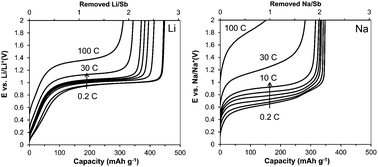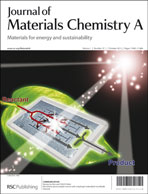Mo3Sb7 thin films prepared by magnetron sputtering are evaluated as an anode material for Li-ion and Na-ion batteries. The as deposited films are amorphous and composed of small agglomerated domains with an overall Sb/Mo ratio of 2.34 that is almost identical to the ratio measured for the starting powder and the expected nominal ratio of 2.33. When cycled with Li and Na, the films show large storage capacities of around 430 and 330 mA h g−1, respectively, with good capacity retention. In addition, micron thick films retain large capacities of about 310 and 280 mA h g−1 at very high rates of 100 and 30 C-rate currents for Li and Na, respectively. The XRD study of the changes in the structure of the electrode material reveals that Li3Sb forms at full discharge whereas the electrode at full charge is amorphous. For the reaction with Na, the electrode material remains amorphous. Analysis of the surface chemistry characterized by XPS suggests the formation of an inorganic layer (LiF, LixPOyFz) covered by organic products (carbonates, esters, ethers) in the case of Li and the formation of an organic layer only (carbonates) in the case of Na. The electrode surface is visible at full charge for Na, thereby indicating that the Solid Electrolyte Interphase (SEI) layer is thinner when cycling with Na compared to that with Li. Overall, the results highlight the very good potential of Mo3Sb7 as an anode for Li- and Na-ion batteries.

You have access to this article
 Please wait while we load your content...
Something went wrong. Try again?
Please wait while we load your content...
Something went wrong. Try again?


 Please wait while we load your content...
Please wait while we load your content...